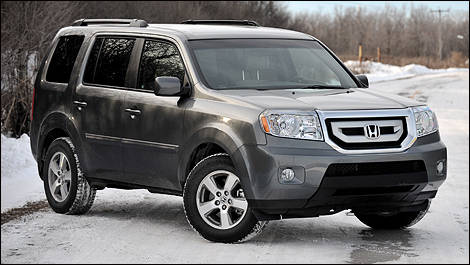Top performance in the roof test is important because nearly 10,000 people a year are killed in rollover crashes. When vehicles roll, their roofs hit the ground, deform, and crush. Stronger roofs crush less, reducing injury risk from contact with the roof itself. Stronger roofs also can prevent people, especially those who aren't using safety belts, from being ejected through windows, windshields, or doors that have broken or opened because the roof deformed. Roofs that don't collapse help keep people inside vehicles when they roll.
The best occupant protection is to keep vehicles from rolling in the first place. Electronic stability control is significantly reducing rollovers, especially fatal single-vehicle ones.
When vehicles roll, side curtain airbags help protect people. Safety belt use is essential.
In the Institute's roof strength test, a metal plate is pushed against 1 corner of a roof at a constant speed. To earn a good rating, a roof must withstand a force of 4 times the vehicle's weight before reaching 5 inches of crush. For an acceptable rating, the minimum strength-to-weight ratio that's required is 3.25. A marginal rating value is 2.5, and anything lower than that is poor. The Grand Cherokee, Highlander, Liberty, and Venza, for example, withstood forces of nearly 5 times their weights. This compares with 2.8 times weight for the Crosstour and about 3 times weight for the Endeavor and Pilot. A strength-to- weight ratio of 4 reflects an estimated 50 percent reduction in serious or fatal injury risk in single-vehicle rollover crashes, compared with the current federal standard of 1.5.
The best occupant protection is to keep vehicles from rolling in the first place. Electronic stability control is significantly reducing rollovers, especially fatal single-vehicle ones.
 |
| 2010 Honda Pilot (Photo: Matthieu Lambert/Auto123.com) |
When vehicles roll, side curtain airbags help protect people. Safety belt use is essential.
In the Institute's roof strength test, a metal plate is pushed against 1 corner of a roof at a constant speed. To earn a good rating, a roof must withstand a force of 4 times the vehicle's weight before reaching 5 inches of crush. For an acceptable rating, the minimum strength-to-weight ratio that's required is 3.25. A marginal rating value is 2.5, and anything lower than that is poor. The Grand Cherokee, Highlander, Liberty, and Venza, for example, withstood forces of nearly 5 times their weights. This compares with 2.8 times weight for the Crosstour and about 3 times weight for the Endeavor and Pilot. A strength-to- weight ratio of 4 reflects an estimated 50 percent reduction in serious or fatal injury risk in single-vehicle rollover crashes, compared with the current federal standard of 1.5.


